Report on Digital System Management, SDLC, and Information Systems
VerifiedAdded on 2023/01/19
|9
|1748
|55
Report
AI Summary
This report provides an overview of digital system management, detailing the System Development Life Cycle (SDLC) and its various stages, including requirements gathering, feasibility studies, design, coding, testing, deployment, and maintenance. It also explores different types of information systems, such as Transaction Processing Systems (TPS), Decision Support Systems (DSS), and Expert Systems, highlighting their roles and applications. The report further examines the essential hardware and software components used in IT management, along with different types of data files. It emphasizes the significance of DSS and Expert Systems in business intelligence and decision-making processes, concluding with the importance of digital system management for organizational success and software project development.
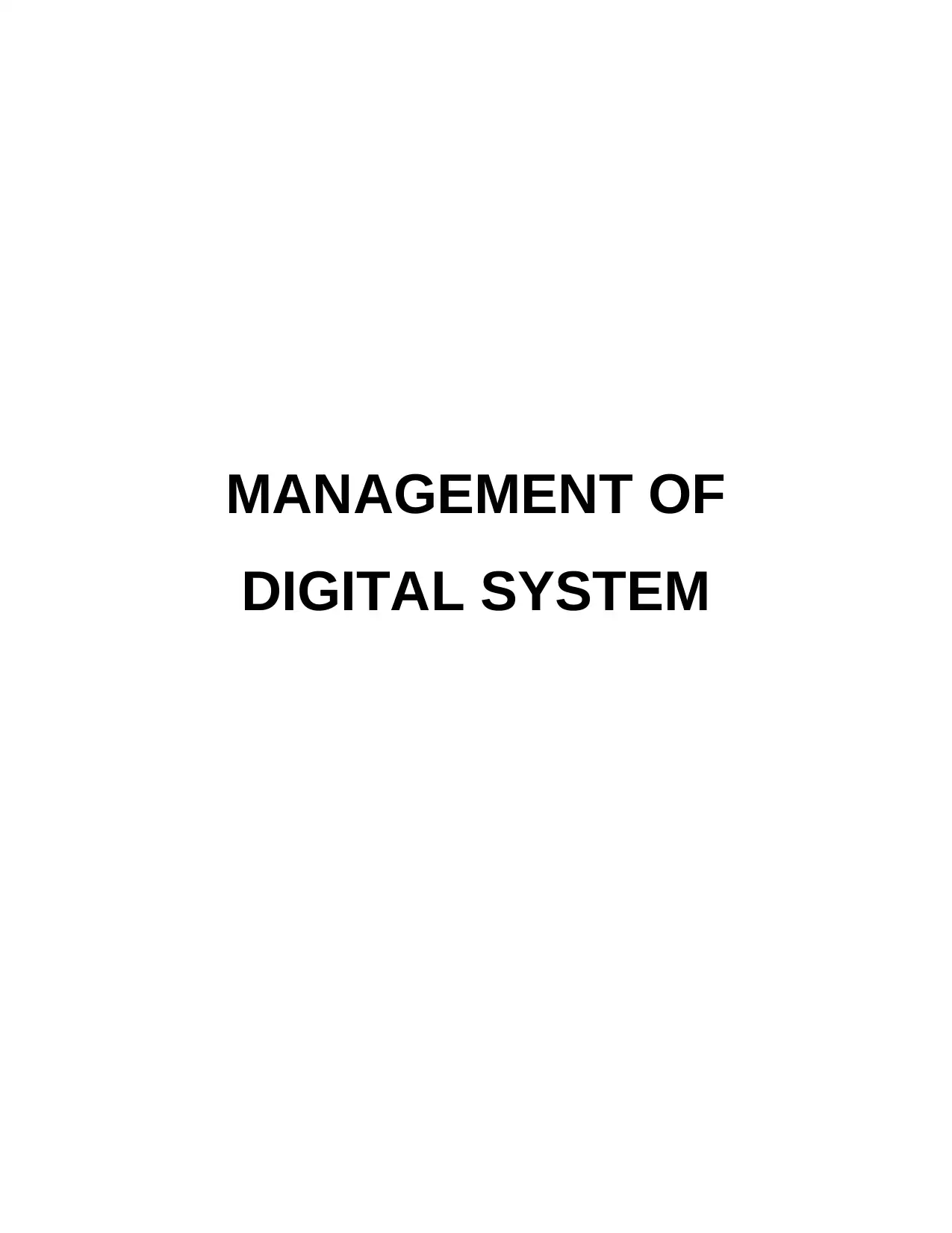
MANAGEMENT OF
DIGITAL SYSTEM
DIGITAL SYSTEM
Paraphrase This Document
Need a fresh take? Get an instant paraphrase of this document with our AI Paraphraser
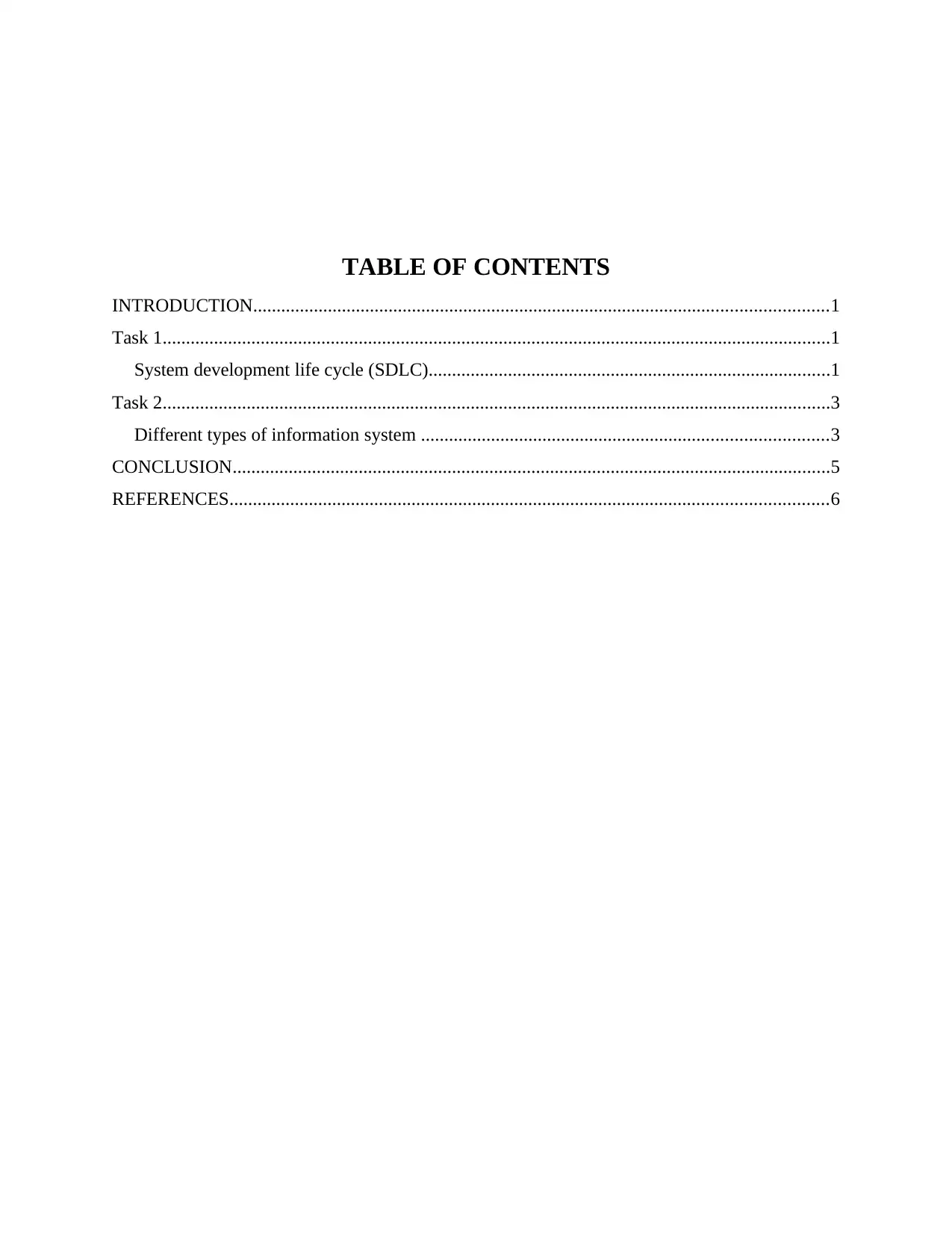
TABLE OF CONTENTS
INTRODUCTION...........................................................................................................................1
Task 1...............................................................................................................................................1
System development life cycle (SDLC)......................................................................................1
Task 2...............................................................................................................................................3
Different types of information system .......................................................................................3
CONCLUSION................................................................................................................................5
REFERENCES................................................................................................................................6
INTRODUCTION...........................................................................................................................1
Task 1...............................................................................................................................................1
System development life cycle (SDLC)......................................................................................1
Task 2...............................................................................................................................................3
Different types of information system .......................................................................................3
CONCLUSION................................................................................................................................5
REFERENCES................................................................................................................................6
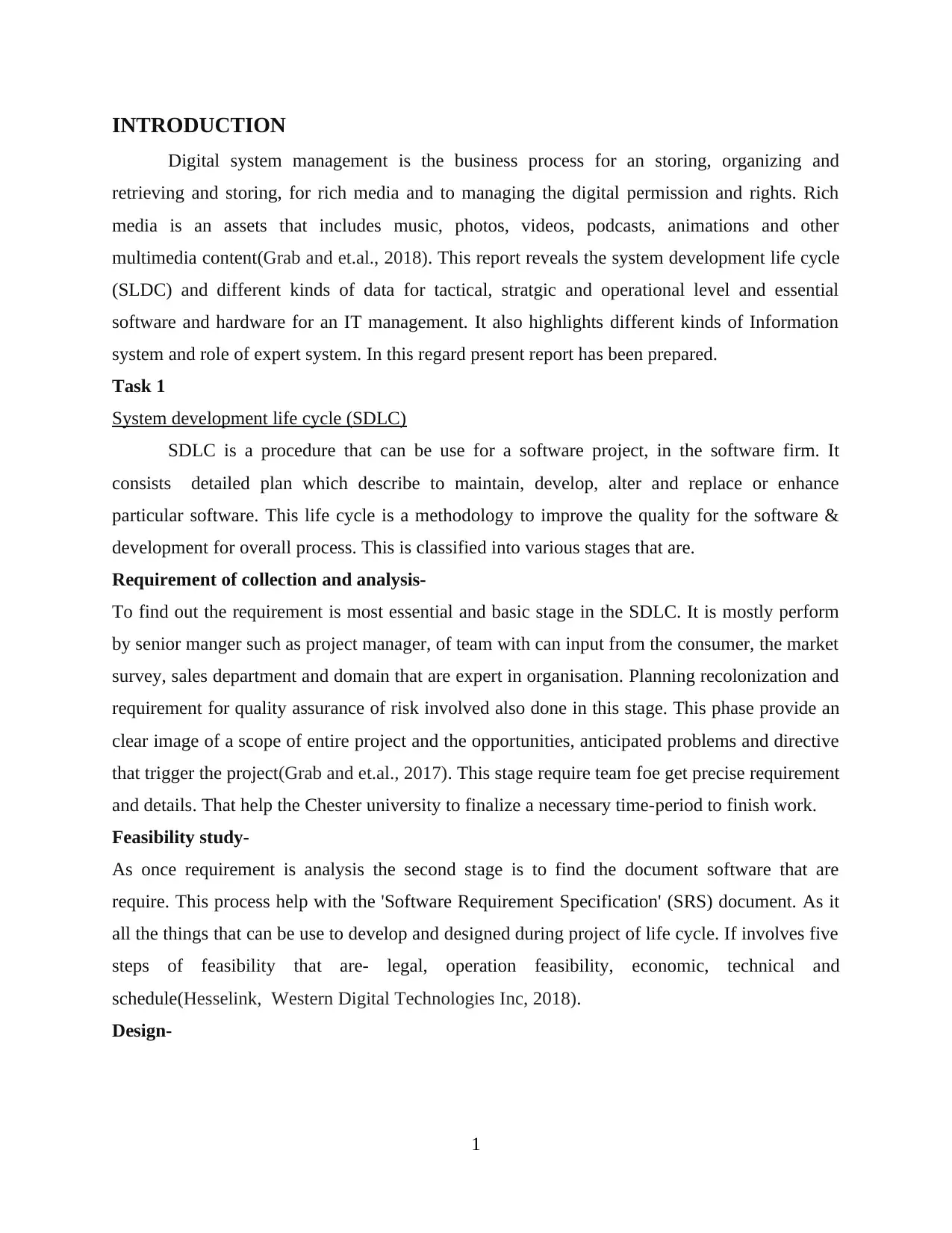
INTRODUCTION
Digital system management is the business process for an storing, organizing and
retrieving and storing, for rich media and to managing the digital permission and rights. Rich
media is an assets that includes music, photos, videos, podcasts, animations and other
multimedia content(Grab and et.al., 2018). This report reveals the system development life cycle
(SLDC) and different kinds of data for tactical, stratgic and operational level and essential
software and hardware for an IT management. It also highlights different kinds of Information
system and role of expert system. In this regard present report has been prepared.
Task 1
System development life cycle (SDLC)
SDLC is a procedure that can be use for a software project, in the software firm. It
consists detailed plan which describe to maintain, develop, alter and replace or enhance
particular software. This life cycle is a methodology to improve the quality for the software &
development for overall process. This is classified into various stages that are.
Requirement of collection and analysis-
To find out the requirement is most essential and basic stage in the SDLC. It is mostly perform
by senior manger such as project manager, of team with can input from the consumer, the market
survey, sales department and domain that are expert in organisation. Planning recolonization and
requirement for quality assurance of risk involved also done in this stage. This phase provide an
clear image of a scope of entire project and the opportunities, anticipated problems and directive
that trigger the project(Grab and et.al., 2017). This stage require team foe get precise requirement
and details. That help the Chester university to finalize a necessary time-period to finish work.
Feasibility study-
As once requirement is analysis the second stage is to find the document software that are
require. This process help with the 'Software Requirement Specification' (SRS) document. As it
all the things that can be use to develop and designed during project of life cycle. If involves five
steps of feasibility that are- legal, operation feasibility, economic, technical and
schedule(Hesselink, Western Digital Technologies Inc, 2018).
Design-
1
Digital system management is the business process for an storing, organizing and
retrieving and storing, for rich media and to managing the digital permission and rights. Rich
media is an assets that includes music, photos, videos, podcasts, animations and other
multimedia content(Grab and et.al., 2018). This report reveals the system development life cycle
(SLDC) and different kinds of data for tactical, stratgic and operational level and essential
software and hardware for an IT management. It also highlights different kinds of Information
system and role of expert system. In this regard present report has been prepared.
Task 1
System development life cycle (SDLC)
SDLC is a procedure that can be use for a software project, in the software firm. It
consists detailed plan which describe to maintain, develop, alter and replace or enhance
particular software. This life cycle is a methodology to improve the quality for the software &
development for overall process. This is classified into various stages that are.
Requirement of collection and analysis-
To find out the requirement is most essential and basic stage in the SDLC. It is mostly perform
by senior manger such as project manager, of team with can input from the consumer, the market
survey, sales department and domain that are expert in organisation. Planning recolonization and
requirement for quality assurance of risk involved also done in this stage. This phase provide an
clear image of a scope of entire project and the opportunities, anticipated problems and directive
that trigger the project(Grab and et.al., 2017). This stage require team foe get precise requirement
and details. That help the Chester university to finalize a necessary time-period to finish work.
Feasibility study-
As once requirement is analysis the second stage is to find the document software that are
require. This process help with the 'Software Requirement Specification' (SRS) document. As it
all the things that can be use to develop and designed during project of life cycle. If involves five
steps of feasibility that are- legal, operation feasibility, economic, technical and
schedule(Hesselink, Western Digital Technologies Inc, 2018).
Design-
1
⊘ This is a preview!⊘
Do you want full access?
Subscribe today to unlock all pages.

Trusted by 1+ million students worldwide
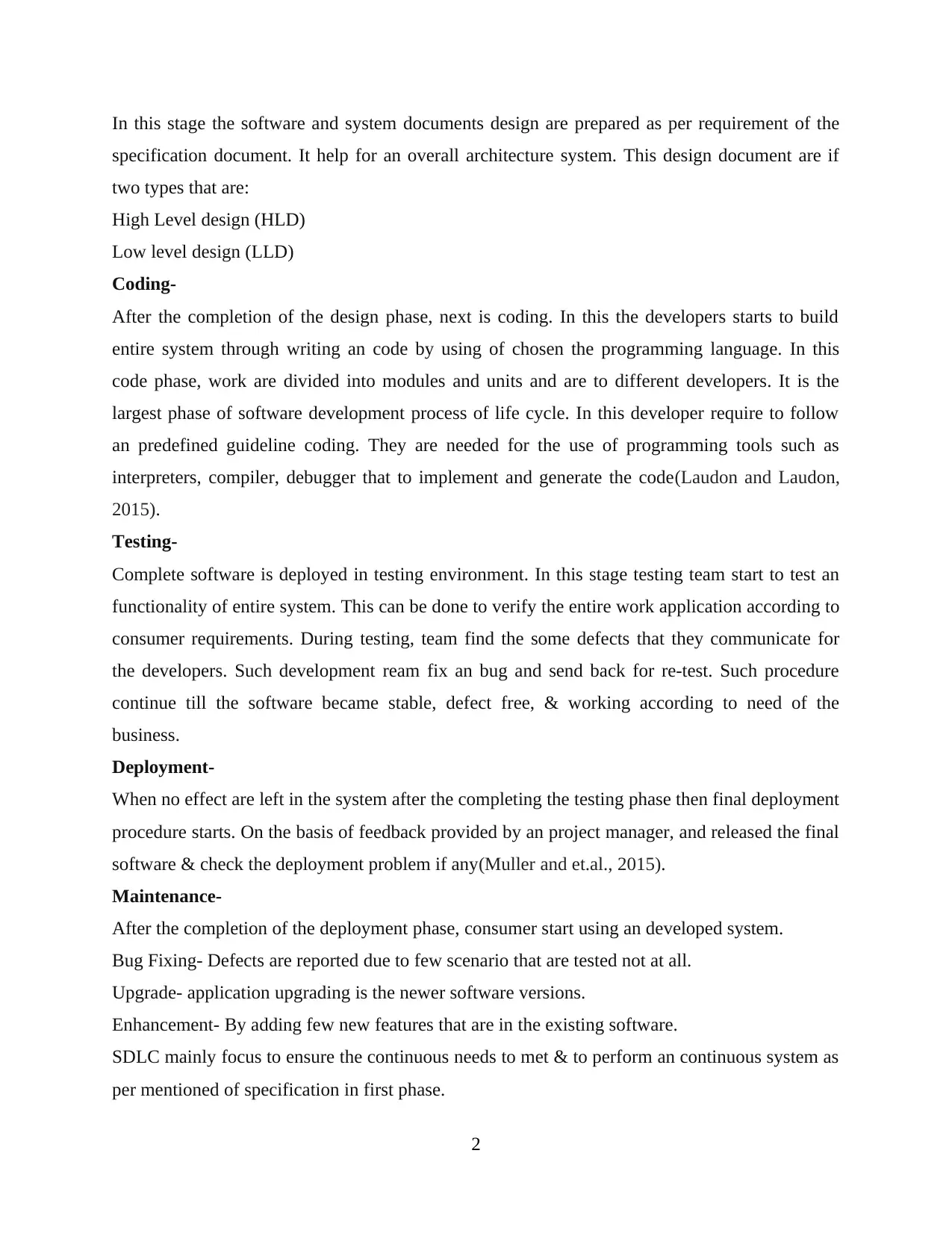
In this stage the software and system documents design are prepared as per requirement of the
specification document. It help for an overall architecture system. This design document are if
two types that are:
High Level design (HLD)
Low level design (LLD)
Coding-
After the completion of the design phase, next is coding. In this the developers starts to build
entire system through writing an code by using of chosen the programming language. In this
code phase, work are divided into modules and units and are to different developers. It is the
largest phase of software development process of life cycle. In this developer require to follow
an predefined guideline coding. They are needed for the use of programming tools such as
interpreters, compiler, debugger that to implement and generate the code(Laudon and Laudon,
2015).
Testing-
Complete software is deployed in testing environment. In this stage testing team start to test an
functionality of entire system. This can be done to verify the entire work application according to
consumer requirements. During testing, team find the some defects that they communicate for
the developers. Such development ream fix an bug and send back for re-test. Such procedure
continue till the software became stable, defect free, & working according to need of the
business.
Deployment-
When no effect are left in the system after the completing the testing phase then final deployment
procedure starts. On the basis of feedback provided by an project manager, and released the final
software & check the deployment problem if any(Muller and et.al., 2015).
Maintenance-
After the completion of the deployment phase, consumer start using an developed system.
Bug Fixing- Defects are reported due to few scenario that are tested not at all.
Upgrade- application upgrading is the newer software versions.
Enhancement- By adding few new features that are in the existing software.
SDLC mainly focus to ensure the continuous needs to met & to perform an continuous system as
per mentioned of specification in first phase.
2
specification document. It help for an overall architecture system. This design document are if
two types that are:
High Level design (HLD)
Low level design (LLD)
Coding-
After the completion of the design phase, next is coding. In this the developers starts to build
entire system through writing an code by using of chosen the programming language. In this
code phase, work are divided into modules and units and are to different developers. It is the
largest phase of software development process of life cycle. In this developer require to follow
an predefined guideline coding. They are needed for the use of programming tools such as
interpreters, compiler, debugger that to implement and generate the code(Laudon and Laudon,
2015).
Testing-
Complete software is deployed in testing environment. In this stage testing team start to test an
functionality of entire system. This can be done to verify the entire work application according to
consumer requirements. During testing, team find the some defects that they communicate for
the developers. Such development ream fix an bug and send back for re-test. Such procedure
continue till the software became stable, defect free, & working according to need of the
business.
Deployment-
When no effect are left in the system after the completing the testing phase then final deployment
procedure starts. On the basis of feedback provided by an project manager, and released the final
software & check the deployment problem if any(Muller and et.al., 2015).
Maintenance-
After the completion of the deployment phase, consumer start using an developed system.
Bug Fixing- Defects are reported due to few scenario that are tested not at all.
Upgrade- application upgrading is the newer software versions.
Enhancement- By adding few new features that are in the existing software.
SDLC mainly focus to ensure the continuous needs to met & to perform an continuous system as
per mentioned of specification in first phase.
2
Paraphrase This Document
Need a fresh take? Get an instant paraphrase of this document with our AI Paraphraser
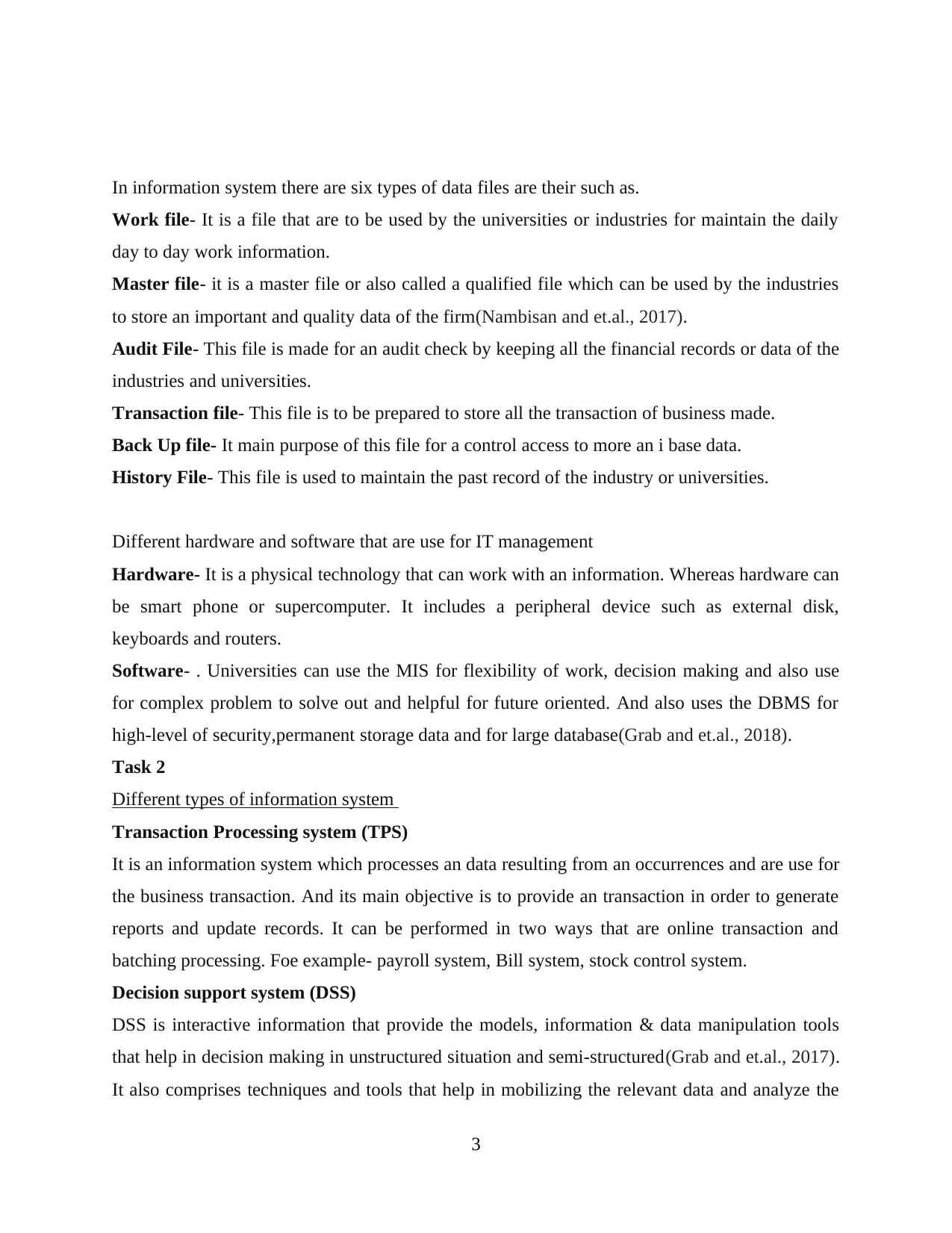
In information system there are six types of data files are their such as.
Work file- It is a file that are to be used by the universities or industries for maintain the daily
day to day work information.
Master file- it is a master file or also called a qualified file which can be used by the industries
to store an important and quality data of the firm(Nambisan and et.al., 2017).
Audit File- This file is made for an audit check by keeping all the financial records or data of the
industries and universities.
Transaction file- This file is to be prepared to store all the transaction of business made.
Back Up file- It main purpose of this file for a control access to more an i base data.
History File- This file is used to maintain the past record of the industry or universities.
Different hardware and software that are use for IT management
Hardware- It is a physical technology that can work with an information. Whereas hardware can
be smart phone or supercomputer. It includes a peripheral device such as external disk,
keyboards and routers.
Software- . Universities can use the MIS for flexibility of work, decision making and also use
for complex problem to solve out and helpful for future oriented. And also uses the DBMS for
high-level of security,permanent storage data and for large database(Grab and et.al., 2018).
Task 2
Different types of information system
Transaction Processing system (TPS)
It is an information system which processes an data resulting from an occurrences and are use for
the business transaction. And its main objective is to provide an transaction in order to generate
reports and update records. It can be performed in two ways that are online transaction and
batching processing. Foe example- payroll system, Bill system, stock control system.
Decision support system (DSS)
DSS is interactive information that provide the models, information & data manipulation tools
that help in decision making in unstructured situation and semi-structured(Grab and et.al., 2017).
It also comprises techniques and tools that help in mobilizing the relevant data and analyze the
3
Work file- It is a file that are to be used by the universities or industries for maintain the daily
day to day work information.
Master file- it is a master file or also called a qualified file which can be used by the industries
to store an important and quality data of the firm(Nambisan and et.al., 2017).
Audit File- This file is made for an audit check by keeping all the financial records or data of the
industries and universities.
Transaction file- This file is to be prepared to store all the transaction of business made.
Back Up file- It main purpose of this file for a control access to more an i base data.
History File- This file is used to maintain the past record of the industry or universities.
Different hardware and software that are use for IT management
Hardware- It is a physical technology that can work with an information. Whereas hardware can
be smart phone or supercomputer. It includes a peripheral device such as external disk,
keyboards and routers.
Software- . Universities can use the MIS for flexibility of work, decision making and also use
for complex problem to solve out and helpful for future oriented. And also uses the DBMS for
high-level of security,permanent storage data and for large database(Grab and et.al., 2018).
Task 2
Different types of information system
Transaction Processing system (TPS)
It is an information system which processes an data resulting from an occurrences and are use for
the business transaction. And its main objective is to provide an transaction in order to generate
reports and update records. It can be performed in two ways that are online transaction and
batching processing. Foe example- payroll system, Bill system, stock control system.
Decision support system (DSS)
DSS is interactive information that provide the models, information & data manipulation tools
that help in decision making in unstructured situation and semi-structured(Grab and et.al., 2017).
It also comprises techniques and tools that help in mobilizing the relevant data and analyze the
3
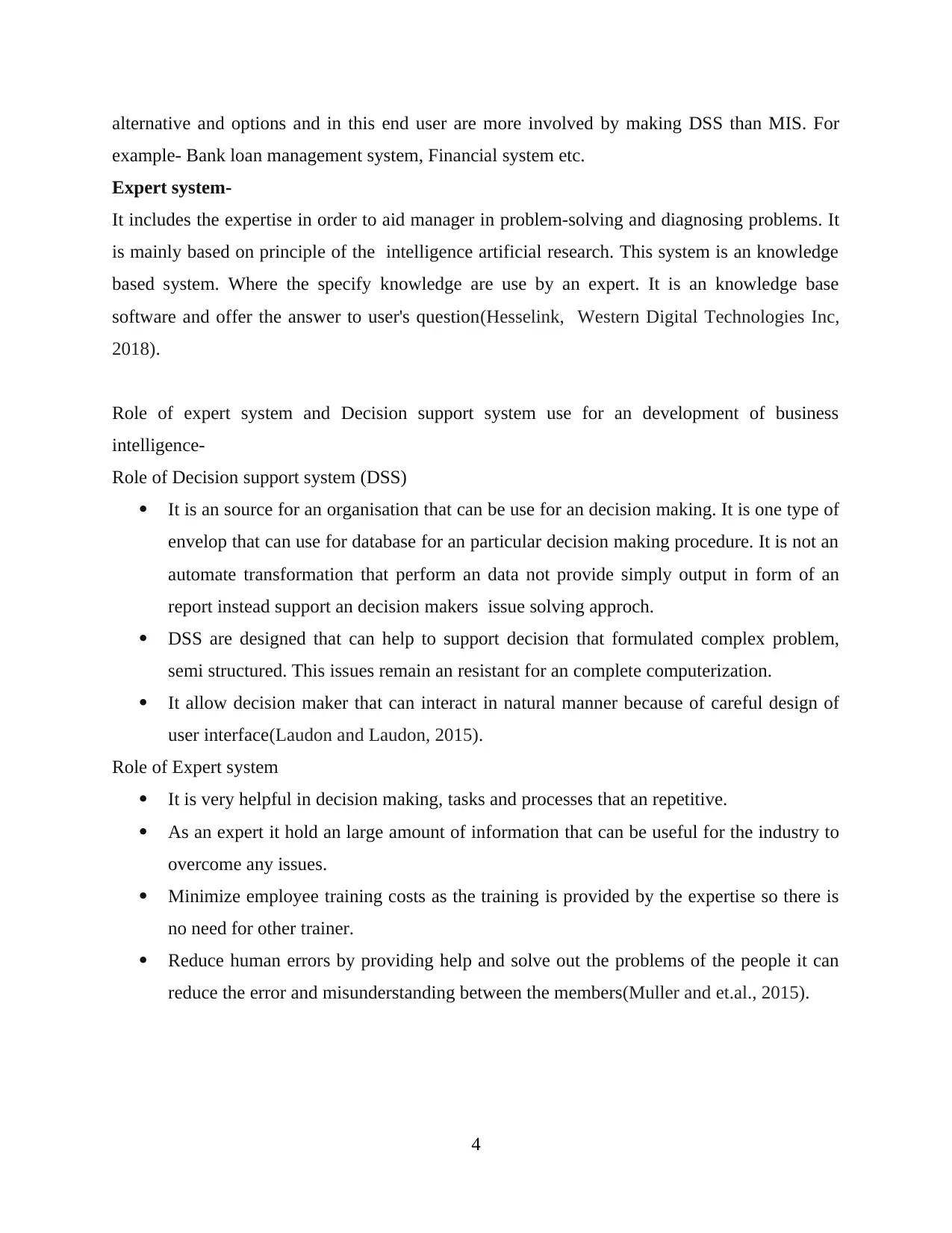
alternative and options and in this end user are more involved by making DSS than MIS. For
example- Bank loan management system, Financial system etc.
Expert system-
It includes the expertise in order to aid manager in problem-solving and diagnosing problems. It
is mainly based on principle of the intelligence artificial research. This system is an knowledge
based system. Where the specify knowledge are use by an expert. It is an knowledge base
software and offer the answer to user's question(Hesselink, Western Digital Technologies Inc,
2018).
Role of expert system and Decision support system use for an development of business
intelligence-
Role of Decision support system (DSS)
It is an source for an organisation that can be use for an decision making. It is one type of
envelop that can use for database for an particular decision making procedure. It is not an
automate transformation that perform an data not provide simply output in form of an
report instead support an decision makers issue solving approch.
DSS are designed that can help to support decision that formulated complex problem,
semi structured. This issues remain an resistant for an complete computerization.
It allow decision maker that can interact in natural manner because of careful design of
user interface(Laudon and Laudon, 2015).
Role of Expert system
It is very helpful in decision making, tasks and processes that an repetitive.
As an expert it hold an large amount of information that can be useful for the industry to
overcome any issues.
Minimize employee training costs as the training is provided by the expertise so there is
no need for other trainer.
Reduce human errors by providing help and solve out the problems of the people it can
reduce the error and misunderstanding between the members(Muller and et.al., 2015).
4
example- Bank loan management system, Financial system etc.
Expert system-
It includes the expertise in order to aid manager in problem-solving and diagnosing problems. It
is mainly based on principle of the intelligence artificial research. This system is an knowledge
based system. Where the specify knowledge are use by an expert. It is an knowledge base
software and offer the answer to user's question(Hesselink, Western Digital Technologies Inc,
2018).
Role of expert system and Decision support system use for an development of business
intelligence-
Role of Decision support system (DSS)
It is an source for an organisation that can be use for an decision making. It is one type of
envelop that can use for database for an particular decision making procedure. It is not an
automate transformation that perform an data not provide simply output in form of an
report instead support an decision makers issue solving approch.
DSS are designed that can help to support decision that formulated complex problem,
semi structured. This issues remain an resistant for an complete computerization.
It allow decision maker that can interact in natural manner because of careful design of
user interface(Laudon and Laudon, 2015).
Role of Expert system
It is very helpful in decision making, tasks and processes that an repetitive.
As an expert it hold an large amount of information that can be useful for the industry to
overcome any issues.
Minimize employee training costs as the training is provided by the expertise so there is
no need for other trainer.
Reduce human errors by providing help and solve out the problems of the people it can
reduce the error and misunderstanding between the members(Muller and et.al., 2015).
4
⊘ This is a preview!⊘
Do you want full access?
Subscribe today to unlock all pages.

Trusted by 1+ million students worldwide
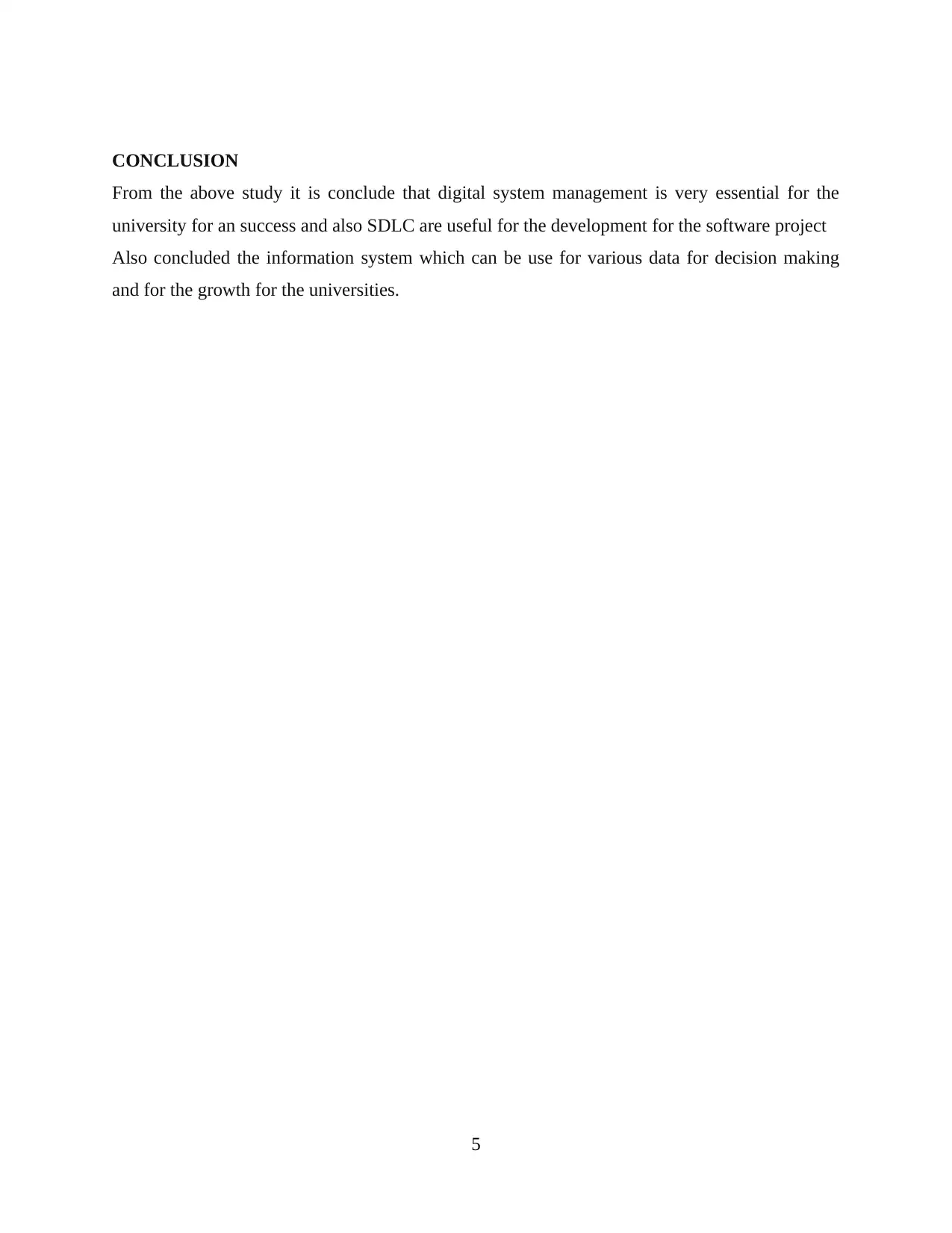
CONCLUSION
From the above study it is conclude that digital system management is very essential for the
university for an success and also SDLC are useful for the development for the software project
Also concluded the information system which can be use for various data for decision making
and for the growth for the universities.
5
From the above study it is conclude that digital system management is very essential for the
university for an success and also SDLC are useful for the development for the software project
Also concluded the information system which can be use for various data for decision making
and for the growth for the universities.
5
Paraphrase This Document
Need a fresh take? Get an instant paraphrase of this document with our AI Paraphraser
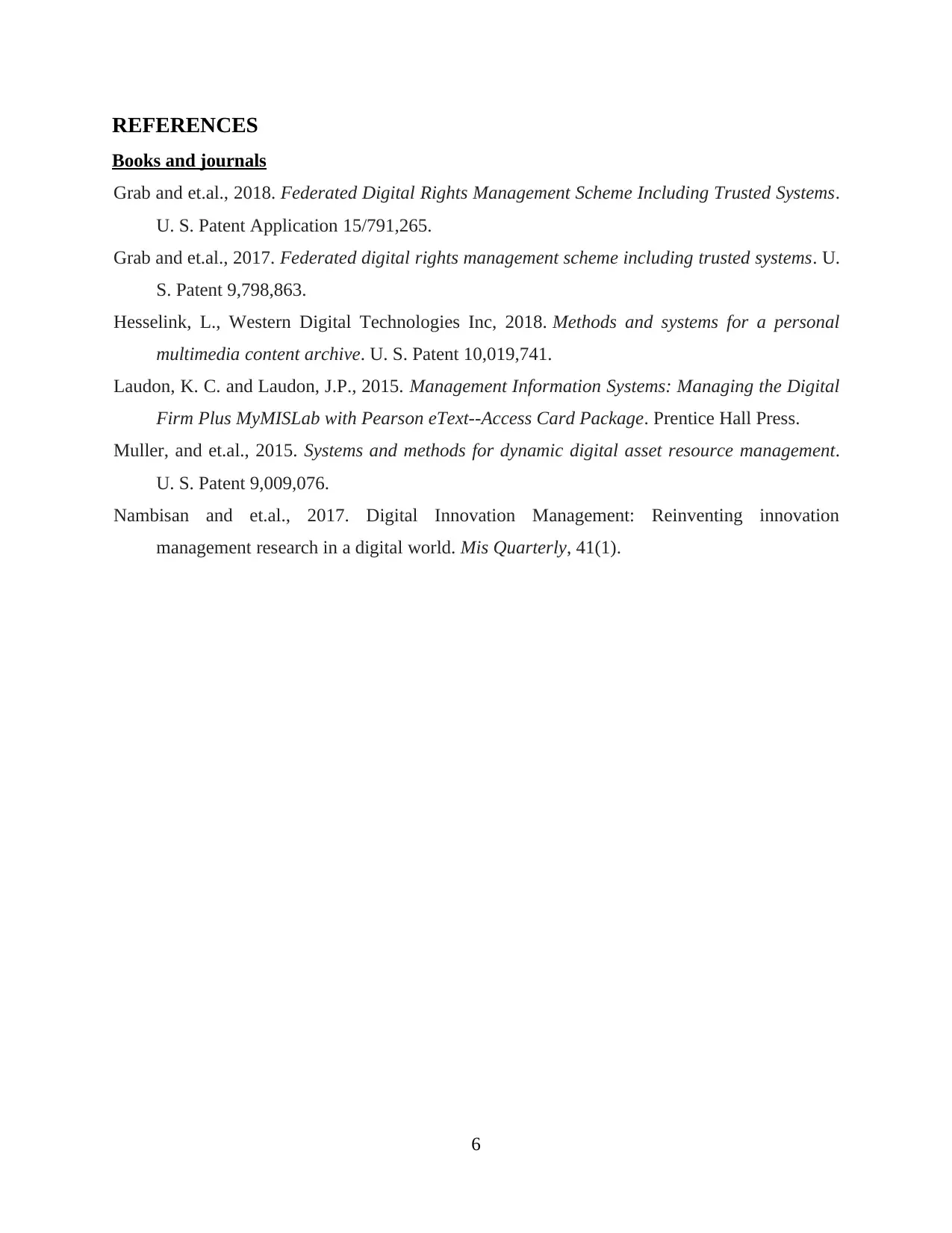
REFERENCES
Books and journals
Grab and et.al., 2018. Federated Digital Rights Management Scheme Including Trusted Systems.
U. S. Patent Application 15/791,265.
Grab and et.al., 2017. Federated digital rights management scheme including trusted systems. U.
S. Patent 9,798,863.
Hesselink, L., Western Digital Technologies Inc, 2018. Methods and systems for a personal
multimedia content archive. U. S. Patent 10,019,741.
Laudon, K. C. and Laudon, J.P., 2015. Management Information Systems: Managing the Digital
Firm Plus MyMISLab with Pearson eText--Access Card Package. Prentice Hall Press.
Muller, and et.al., 2015. Systems and methods for dynamic digital asset resource management.
U. S. Patent 9,009,076.
Nambisan and et.al., 2017. Digital Innovation Management: Reinventing innovation
management research in a digital world. Mis Quarterly, 41(1).
6
Books and journals
Grab and et.al., 2018. Federated Digital Rights Management Scheme Including Trusted Systems.
U. S. Patent Application 15/791,265.
Grab and et.al., 2017. Federated digital rights management scheme including trusted systems. U.
S. Patent 9,798,863.
Hesselink, L., Western Digital Technologies Inc, 2018. Methods and systems for a personal
multimedia content archive. U. S. Patent 10,019,741.
Laudon, K. C. and Laudon, J.P., 2015. Management Information Systems: Managing the Digital
Firm Plus MyMISLab with Pearson eText--Access Card Package. Prentice Hall Press.
Muller, and et.al., 2015. Systems and methods for dynamic digital asset resource management.
U. S. Patent 9,009,076.
Nambisan and et.al., 2017. Digital Innovation Management: Reinventing innovation
management research in a digital world. Mis Quarterly, 41(1).
6

7
⊘ This is a preview!⊘
Do you want full access?
Subscribe today to unlock all pages.

Trusted by 1+ million students worldwide
1 out of 9
Related Documents
Your All-in-One AI-Powered Toolkit for Academic Success.
+13062052269
info@desklib.com
Available 24*7 on WhatsApp / Email
![[object Object]](/_next/static/media/star-bottom.7253800d.svg)
Unlock your academic potential
Copyright © 2020–2025 A2Z Services. All Rights Reserved. Developed and managed by ZUCOL.





